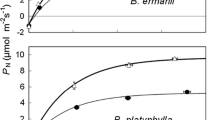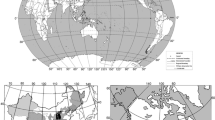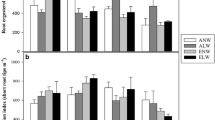Abstract
Three birch species (Betula ermanii, B. maximowicziana, B. platyphylla var. japonica) widespread in northern Japan were raised under different water regimes (ca. 23, 35, and 60%) to study root-shoot increment and gas exchange traits in relation to their habitat preferences in natural conditions. Total biomass of all birches was larger for medium, wet and dry treatment. Maximum root length of B. platyphylla raised at dry or wet condition was higher than other species. Root growth rate of three birches peaked around mid July to early September while shoot growth rate was found maximum between late June and mid August. Root growth of three birches was suppressed under dry and wet treatment, especially for B. ermanii. Allocation percentage of biomass to roots of three birches ranged from 30 to 40% but it mainly allocated to elongate the root length under dry and wet condition. Fine roots of B. ermanii and B. maximowicziana under wet condition were distributed mainly on soil surface. In the dry treatment, B. platyphylla allocated photosynthates to elongate the root length and fine root production (<2 mm) and had highest plasticity of roots to different water conditions among the three birches. Specific leaf area (SLA) of three birches decreased with decreasing soil moisture content. Plasticity in SLA of B. platyphylla was found largest. Net photosynthetic rate (Pn) and water use efficiency (WUE) of B. platyphyllashowed highest among all the treatments. Leaf nitrogen content of B. platyphyllawas also relatively higher under different water conditions as compared to the other two birch species, suggesting B. platyphylla may enable to invade to various growing conditions with different water regimes.
Similar content being viewed by others
References
Berntson G M, Wayne P M and Bazzaz F A 1997 Below-ground architectural and mycorrhizal responses to elevated CO2 in Betula alleghaniensis populations. Funct. Ecol, 11, 684-695.
Farley F A and Fitter A H 1999 Temporal and spatial variation in soil resources in a deciduous woodland. J. Ecol, 87, 688-696.
Fitter A H 1994 Architecture and biomass allocation as component of the plastic response of root systems to soil heterogeneity. In Exploitation of Environmental Heterogeneity by Plants. Eds. M M Caldwell and R W Pearcy. pp. 305-325 Academic Press New York. San Diego.
Fitter A H 1996 Characteristics and functions of root systems. In Plant Roots: the Hidden Half. Eds. Y Waisel, A Eshel and U Kafkafi. pp. 1-20. Marcel Dekker, New York
Fitter A H 1999 Roots as dynamic systems: the developmental ecology of roots and root systems. In Physiological Plant Ecology, BES. pp. 115-131. Blackwell Scientific Co. UK.
Fitter A H and Hay R K M2002 Environmental Physiology of Plants 3 ed. Academic Press Dan Diego, pp. 367.
Haynes B E and Gower S T 1995 Belowground carbon allocation in unfertilized and fertilized red pine plantations in northern Wisconsin. Tree Physiol, 15, 317-325.
Hendrick R L and Pregitzer K S 1996 Temporal and depth-related of fine root dynamics in northern hardwood forests. J. Ecol. 84, 167-176.
Jackson R B, Pockman W T and Hoffmann W A 1999 The structure and function of root systems. In Handbook of Functional Plant Ecology. Eds. F I Pugnaire and F Valladares. pp. 195-220. Marcel Dekker Inc. NY.
Koike T 1985 Effects of the moisture gradient on the growth process in three species of birch seedlings. Transaction of Japanese Forestry Society 96, 315-316 (in Japanese).
Koike T 1990 Autumn coloring, photosynthetic performance and leaf development of deciduous broad-leaved trees in relation to forest succession. Tree Physiol, 7, 21-32.
Koike T 1995 Physiological ecology of the growth characteristics of Japanese mountain birch in Northern Japan: a comparison with Japanese white birch. In Vegetation Sciences in Forestry, Kluwer Scientific. Eds. E O Box et al. pp. 409-422. The Netherlands.
Kozlowski T T and Pallardy S G. 1997 Physiological of woody plants. 2nd ed., Academic Press, San Diego, pp. 411.
Larcher W 2003 Physiological plant Ecology 4 ed. Springer Verlag. 513 pp.
Lechowicz M J and Bell G 1991 The ecology and genetics of fitness in forest plants. II. Microspatial heterogeneity of the edaphic environment. J. Ecol. 79, 687-696.
Meinzer F C and Goldstein G 1996 Scaling up from leaves to whole plants and canopies for photosynthetic gas exchange. In Tropical Forest Plant Ecophysiology. Eds. S S Mulkey et al. pp. 114-138. Chapman & Hall.
Nilsen E T and Orcutt D M 1996 Physiology of Plants Under Stress, Abiotic factors, John Wiley Sons, New York.
Persson H 1983 The distribution and productivity of fine roots in boreal forests. Plant Soil 71, 87-101.
Sakagami Y 1988 Edaphic and topographic conditions of the representative tree species native to northern Japan. In Practical Forestry of Natural Forests. Eds. Q & A Hokkaido Forest Office, Y Sakagami and S Ishida. pp. 121-124. Association of Northern Forestry (in Japanese).
Sanada M 1976 Baseline data of soil properties in the experiment nursery of Hitsujigaoka station. Bulletin Forestry and Forest Products Research Institute. S46, 18-23 (in Japanese).
Sato T 1995 Fundamental studies on the root growth of trees in Hokkaido. Bulletin Hokkaido For. Res. Inst., 31, 1-54 (in Japanese).
Schulze E-D and Hall A E 1982 Stomatal responses, water loss and CO2 assimilation rates of plats in contrasting environments. In Ency Plant Physiological Ecology 12B, 181-230.
Tabata H 1966 A contribution to the biology of Japanese birches. Memories of the College of Science, Kyoto University, Series B, 32, 239-271.
Tabata H 1971 Root habit of Japanese birches (Betula). Memories of the Faculty of Science, Kyoto University, Series Biology 4, 130-138.
Tuner H, Streule A, Schonenberger W and Hasler R 1982 Above and below ground growth of larch and mountain pine grown at contrasting north-and east-facing slopes in Stillberg, Switzerland. In IUFRO Workshop. Ed. R H Waring. pp. 28-36. Switzerland.
Vanninen P and Makela A 1999 Fine root biomass of Scots pine stands differing in age and soil fertility in southern Finland. Tree Physiol, 19, 823-830.
Vogt K A, Publicover D A, Bloomfield J, Perez J M, Vogt D J and Silver W L 1993 Below ground responses as indicators of environmental change. Environ. Exp. Bot, 33, 189-205.
Weih M2000 Delayed growth response of Mountain birch seedlings to a decrease in fertilization and temperature. Func. Ecol, 14, 566-572.
Author information
Authors and Affiliations
Corresponding author
Rights and permissions
About this article
Cite this article
Koike, T., Kitao, M., Quoreshi, A.M. et al. Growth characteristics of root-shoot relations of three birch seedlings raised under different water regimes. Plant and Soil 255, 303–310 (2003). https://doi.org/10.1023/A:1026199402085
Issue Date:
DOI: https://doi.org/10.1023/A:1026199402085




